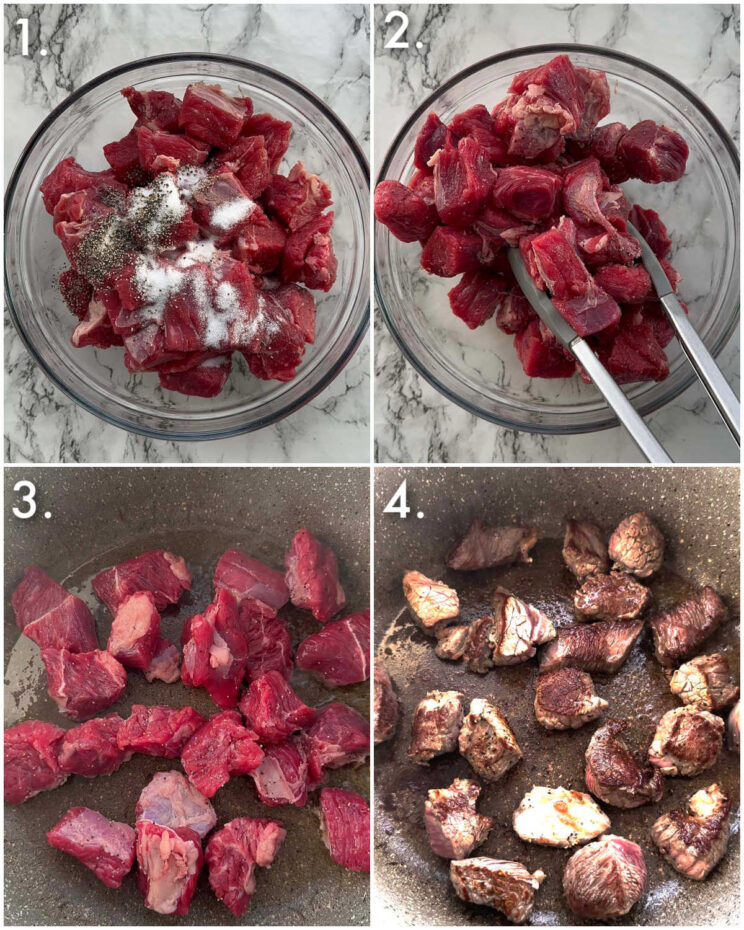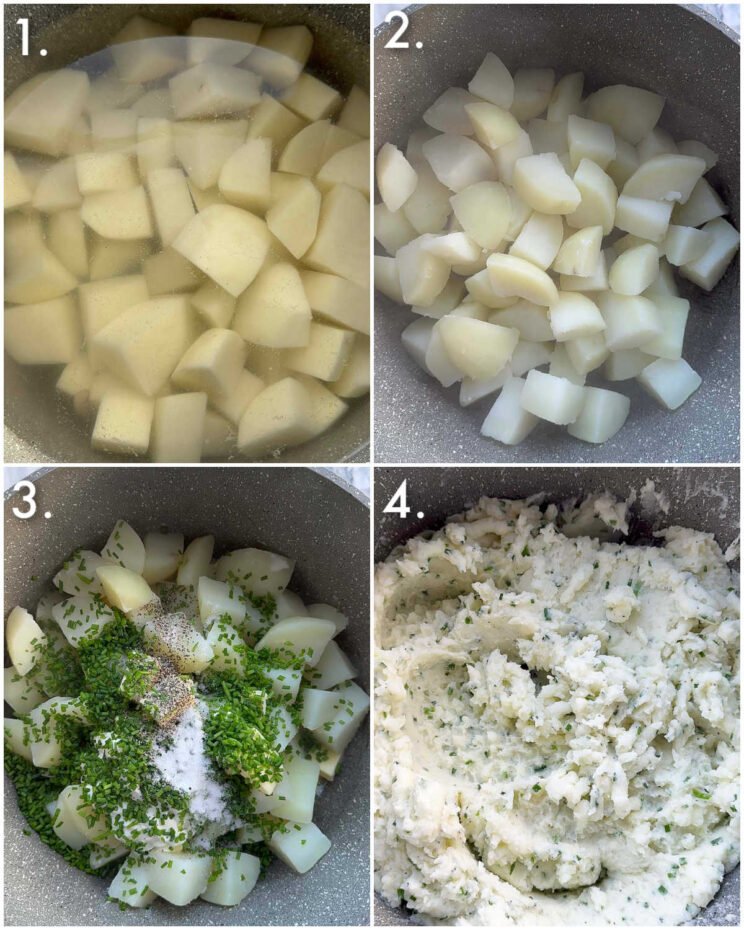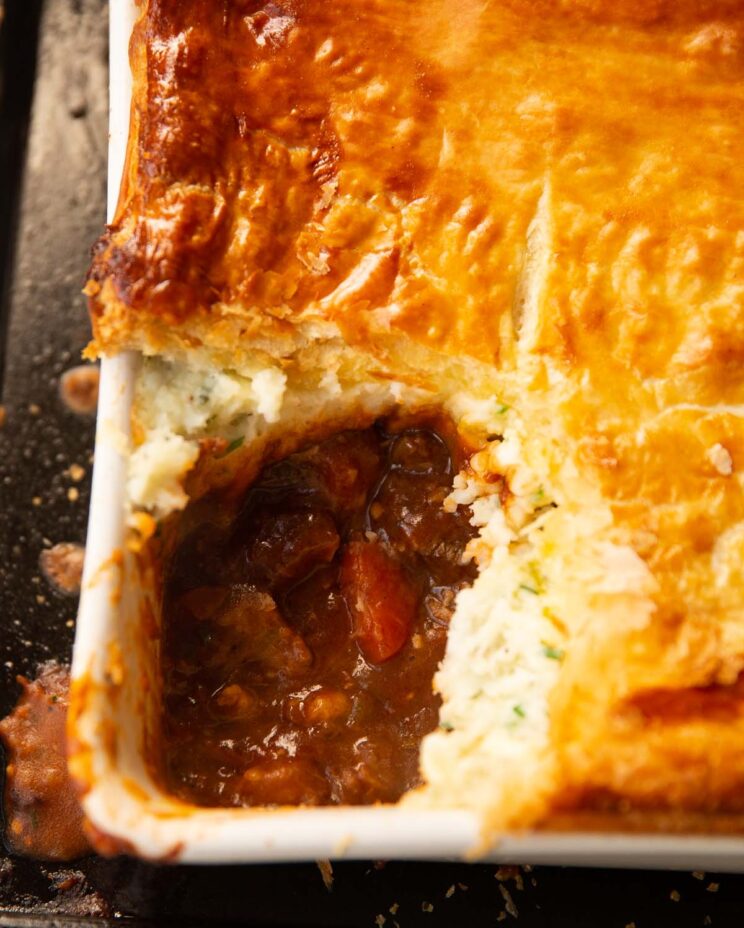I think this may be the pie to end all pies. It truly has it all and once you give it a go, I know it’s going to go on repeat! Follow me…
Steak Pie
I know it’s called a ‘steak’ pie, but don’t worry, you don’t need to buy any fancy cuts of steak. ‘Steak’ pie just refers to it being a chunky beef pie.
What kind of beef should I use?
You’ll want a cut of beef that’s suitable for braising/slow cooking. My choice is always beef chuck, which you’ll find in all butchers and some supermarkets. If not, anything else that has marbled fat and is suitable for slow cooking will work. The marbled fat is important as it ensures the beef stays tender over the long cooking time. Do not use lean beef! It will come out dry and chewy.
Preparing the beef
This happens in two stages:
Slicing – slice the beef into fairly large bite-sized pieces. Larger chunks will be more robust throughout the cooking process (they’ll break down as they cook). Seasoning – whilst the beef will soak in some flavour from the gravy, it’s always a good idea to season the meat directly before cooking.
Frying the beef
I like to sear the beef before it simmers, just to develop a bit more flavour. You’ll want to work in batches and over a very high heat. You don’t need to cook the beef at this point, just brown the outside. Doing this will also create ‘fond’ in the base of the pot, which in turn adds more flavour to the gravy. Process shots: slice and season beef (photos 1&2), fry in batches (photos 3&4).
Steak and Guinness Pie Filling
First things first – I do not like drinking Guinness. Stick with me here 😂
Why use Guinness?
The flavour of the Guinness actually mellows quite significantly as the filling cooks, so it doesn’t actually taste much of Guinness at all. Instead, the Guinness helps to create a deep rich savoury flavour to the stew. Don’t worry, the alcohol will also burn off too.
Simmering the filling
Giving the stew a nice long simmer is important for a few different reasons:
Beef – a long and low simmer will help tenderise the beef. Flavour – it gives time for all of the flavours to condense and marry together. Thickening – simmering will reduce and thicken the sauce.
Thickening the filling
We’re going to simmer the filling first with the lid on and then with the lid off. Taking the lid off allows the steam to escape and gives an opportunity for the filling to reduce and naturally thicken. Thickening the filling is important. If it’s too watery the mash will simply collapse into it. Not a huge deal if it does, but it’s nice to have separate layers. Process shots: fry bacon (photo 1), fry onion, carrot, celery and garlic (photo 2), stir in flour (photo 3), add beef stock, Guinness, tomato puree, Worcestershire sauce, brown sugar, thyme and bay leaves (photo 4), stir (photo 5), simmer to thicken (photo 6).
Sour Cream and Chive Mashed Potato
Not only is sour cream and chive a match made in heaven, but it works so delightfully in this recipe. Having a slightly ‘lighter’ mash in this recipe is nice as the filling is pretty rich. I say ‘lighter’ in quotations because there’s still 6 tablespoons of butter in it 😅 The chives also work nicely for a gorgeous burst of flour.
Steam drying the potatoes
Once you’ve boiled the potatoes, allow them to steam dry for a little while to remove some moisture. You want the mash fairly firm otherwise it’ll sink into the filling as it bakes. Process shots: boil potatoes (photo 1), drain (photo 2), add butter, milk, sour cream, chives and s&p (photo 3), mash (photo 4).
Steak and Guinness Pie
Okay, mash and filling done, time to stack.
Cooling the filling
Once you add the filling to the baking dish it is essentially that you let it cool. This is so a skin forms which works as a protective layer to help prevent the mash from sinking in. I actually usually make this ahead of time and store it in the fridge, just to properly firm it up. When you add the mash just gently plonk it on then smooth over the top. After that, it’s time for the Cheddar cheese. Not only does this of course add flavour, but I find it adds a protective layer between the mash and the pastry. I first tested this with no cheese and found the mash stuck slightly to the pastry, preventing it from puffing up to its full potential. Process shots: cool filling (photo 1), add mash (photo 2), smooth until flat (photo 3), add cheese (photo 4), add puff pastry, slice steam holes and brush with egg wash (photo 5), bake (photo 6).
Do I have to add Guinness?
This is a key ingredient (as you can imagine in a steak and ‘Guinness’ pie) so definitely don’t substitute it. The alcohol will burn off and the flavour mellows significantly. I believe they also make zero-alcohol Guinness though if you can’t use alcohol in any capacity (although I haven’t tried it myself I’m assuming it’s very similar!).
Do I have to add the pastry?
I love mash with my pie, so the pastry makes sense to me. I’m sure it’ll still be delicious without though.
How do I know when the pie is cooked?
The pastry will turn very deep golden and will be visibly crisp. The filling will also start bubbling and leaking around the edges.
Serving Steak and Guinness Pie
Once the pie is done, just let it sit for 5 or so minutes before serving. Just to let it reform its shape (and so you don’t lose the roof of your mouth). This is a very hearty pie so you don’t need sides. But you could add some Green Beans or Broccolini if you wanted to. Alrighty, let’s tuck into the full recipe for this steak and guinness pie shall we?!
How to make Steak and Guinness Pie (Full Recipe & Video)
For more similar recipes check out these beauties:
Potato Pie Recipes
Steak and Potato Pie Sausage and Mash Pie Shepherd’s Pie (or Sweet Potato Shepherd’s Pie or Cottage Pie) Waffle Cowboy Pie Chicken and Bacon Pie







